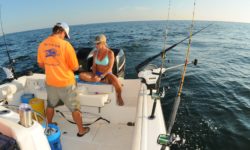"Brown Bombers"
By Terry Lacoss
One of Amelia Island's favorite and best eating saltwater game fish have now arrived in our popular fishing waters. Cobia are not only excellent eating when prepared a variety of ways, but are also extremely colorful game fish when targeted on the fly, with lures and live/dead baits.
Local saltwater fishermen often stumble into cobia while cast netting live menhaden, jigging up live baits offshore, or while simply looking face to face with a cobia that simply swam up to their fishing boat.
However a tried and true cobia fishing tactic includes running the St. Mary's buoy line during a flooding tide when water clarity is best. Cobia weighing to over fifty-pounds will hold tight to channel markers while prospecting for an easy meal. Here bait fish will hold on the heavy chains that anchor the buoys solid in the strong seas and heavy tides.
Cobia fishermen will need to keep the sun on their back, wear a good pair of sunglasses and be prepared to cast a bait, or lure to cobia holding close to channel buoys that seem to pop into sight without notice.
In many cases making noise in the water will also attract the inquisitve cobia to your fihsing boat by tilting you outboard motor up, allowing the propeller to cavitate on the surface. Also making a splash with your rod tip is also a unique way in getting cobia to show up at boatside.
During a past offshore cobia fishing trip we were slow trolling live menhaden at the popular FA live bottom when a single cobia simply swam up my Amelia Angler sport fishing boat. I handed my customer a heavy spinning rod and reel rigged with a two-ounce bucktail jig and instructed my guests to cast the jig just past the head of the cobia and begin reeling it right past its head. In many cases taking a bait or lure away from a cobia excites their competitive feeding habits!
As predicted once my guest began to speed up his retrieve, taking the jig away from the cobia prompted the cobia to chase the jig down and strike the lure. Once the hook was set, the cobia swam deep down to the lime rock ledge below and soon returned with an entire school of cobia!
Soon all my charter guests were hooked up to hard fighting cobia while I occasionally tossed live and dead menhaden into the water to hold the cobia close to my sport fishing boat.
This same senario happens time and time again while fishing a variety of ways for Amelia Island saltwater game fish. Including cast netting menhaden along the beaches, bottom fishing at the St. Mary's inlet, or live baiting at offshore wrecks and live bottoms. Cobia will simply swim up to your sport fishing boat and beg for a good fight!
In many cases the fight really begins once the angler has gaffed his cobia and slung the heavy brown fish into his fishing boat. Once landed on the deck, a large cobia has been known to tear up fishing gear and also injure nearby fishermen as well while twisting, jumping a browling wildly in their fishing boat. It is not uncommon for fishermen to take cover by jumping up on a nearby cooler to avoid being the hunted instead of the hunter! Having on board a baseball bat is an excellent idea while making sure you hit a homerun before the cobia is brought into the boat.
A tried and true cobia setup includes a seven-foot medium heavy action spinning rod with a large spooled spinning reel that can hold 200-yards of forty-pound green braided fishing line. A three-foot length of forty-pound fluorocarbon shock leader is attached to the tag end of the braided fishing line using back to back "Uni Knots". A four-ounce bucktail jig in the chartruese color pattern is then attached to the tag end of the shock leader using a "Loop Knot". Cobia fishermen can also barb a live bait to the jig hook and fish it deep on the bottom or cast it to surface holding cobia.
Its hard to beat cobia steaks grilled on a charcoal grill!
Florida Wildlife Commission game fish regulations allow fishermen to keep one fish per day, or a maximum of six per vessel measuring at least 33-inches to the fork of the tail. For more fishing regulations please visit myfwc.com












